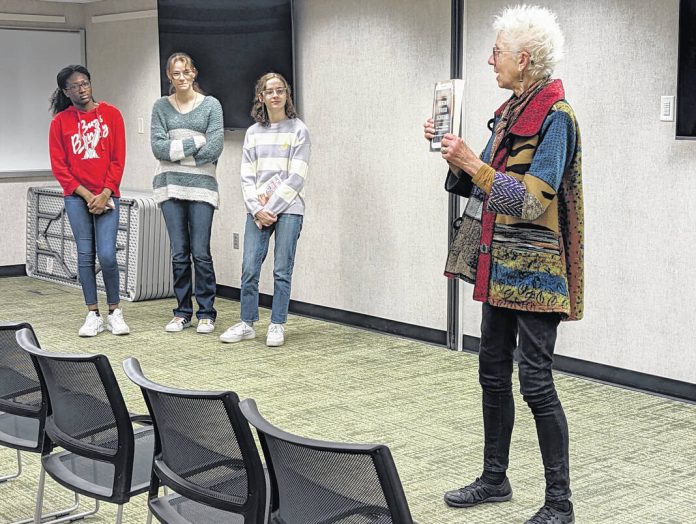
Drama teacher Jo Beth Gonzalez, right, introduces an original play on social media and body dysmorphia, acted and written by Bowling Green High School Drama Club members Chidiogo Onyekelu, left, Sophia Mercer and Ramona Foreman.
Roger LaPointe | Sentinel-Tribune
PERRYSBURG — The dangers of internet selfie culture were presented at the Way Public Library by Bowling Green State University Professor John Dowd, Ph.D., and members of the Bowling Green High School Drama Club.
Dowd’s presentation on his research into social media and body dysmorphic disorder set the stage for an original play presented by drama club members Ramona Foreman, Sophia Mercer and Chidiogo Onyekelu.
“We’re going to talk a little bit about social media and AR, or augmented reality and specifically how beauty in the palm of your hand becomes this seductive and alluring opportunity for people,” Dowd said. “Our ideas, our self-perceptions, our ideas of ourselves, don’t only impact how we feel about ourselves, but they impact how we relate to one another.”
Dowd showed the evolution of the social media selfie and modern image augmentation that has become pervasive in both social media platforms and cell phone camera technology.
Part of that evolution began with roots in kawaii, or the Japanese culture of cuteness that is primarily directed at young girls.
In the mid-1990s photo booths evolved into the first front-facing camera on a cellphone by Kyocera. Self-portraits with cameras were not new, but the combination of instant digital photographs with the front-facing technology made selfies easily accessible to anyone.
Then in the early 2000s, the social media platforms MySpace and Facebook further popularize selfies.
Today, Facetune, Snapchat, Instagram and TikTok platforms provide beauty enhancing photo and video filters. They allow the changing the size and shape of facial features, including modification of lips, skin tone, lifted eyebrows and skin smoothing.
“It’s a little difficult to get away from these,” Dowd said.
Part of the difficulty is the technology, and part is etiquette.
For example, it wouldn’t be considered polite to make improvements to your own face without also improving your friend’s face in a group photo. Some of the social media platforms have gone so far as to automatically apply the filters without consent or permission.
“With this self perception, we are constantly evaluating how we are perceived in the eyes of other people, so much so, to the point that we are starting to see ourselves from a third person perspective. We are starting to see ourselves as an object, instead of a fully realized subject, able to make decisions and choices,” Dowd said.
Research has shown that since the start of the pandemic there has been a dramatic increase in plastic surgery, with some surgeons reporting that pictures are being brought into the clinics which are physically impossible to replicate in real life.
The discussions are comparable to the old criticisms of Barbie dolls — “except it’s now ourselves,” Dowd said.
The result is body dysmorphic disorder, a health condition resulting in anxiety about physical appearance and perceived defects. There are also sub-categories of Zoom dysmorphia and Snapchat dysmorphia.
His research has shown a 20% increase in usage of various beautification filters from the start of the pandemic, with a 40% spike in young users. There are an estimated 1-1.5 million Facetuned photos exported daily, which does not include the other platforms and in-camera app generated beautification filters.
Dowd said that colorism has also been promoted with this technology. While it can affect any race, the main features associate lighter skin with purity and wealth, while darker skin is associated with sin and poverty. Some of the various social media platforms, filters and lenses allow and promote skin lightening as beautification.
Following Dowd’s presentation, three drama club members, all part of Bowling Green High School drama teacher Jo Beth Gonzalez’s drama class, presented their original play.
The origin of the play was based off the concept of Snow White and the mirror, but the fictitious social media adviser was called TikTok, as played by Foreman. Mercer and Onyekelu played high school girls in the weeks leading up to prom. They would bounce preparation ideas off each other between classes.
Between those conversations in the hall Mercer would consult with TikTok, asking about the other girls’ increasingly extreme suggestions on ways she could improve her looks, from sucking in her stomach, to getting a tummy tuck and Lasik surgery.
“The scene is not presented as an answer. When it stops, that’s an opportunity for us to think about what intervention is possible to prevent further forward motion, as a result of social media,” Gonzalez said.
The 10-minute play resulted in a vigorous discussion, with suggestions for calls to politicians to require permissions on beautification filters, but also support for those affected by body dysmorphia and boycotts of the companies that promote the technology.
Dowd recommends two resources: the Cleveland Clinic website pages on body dysmorphia and www.thebeautywell.org for colorism.




